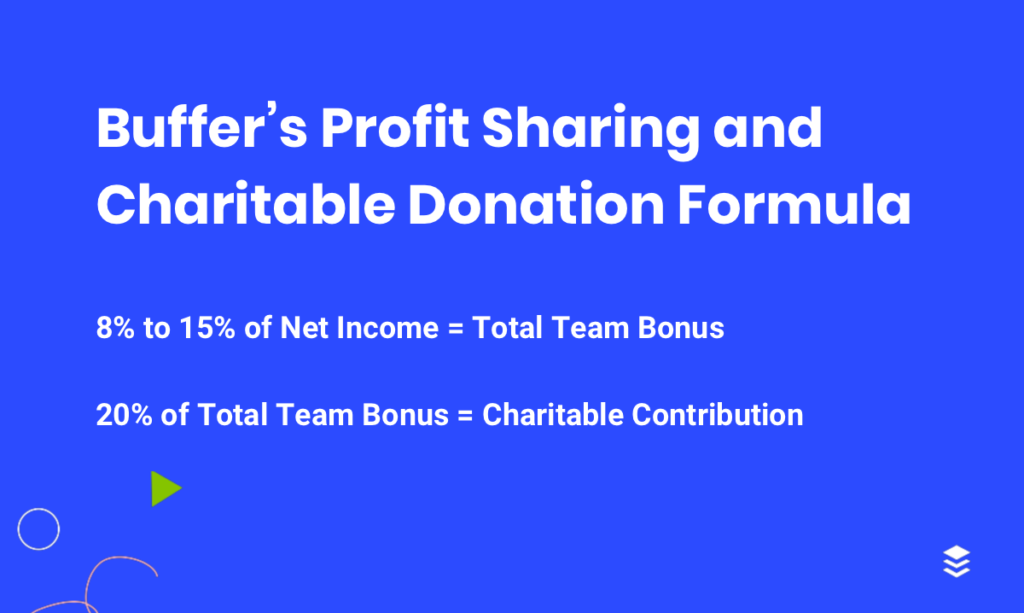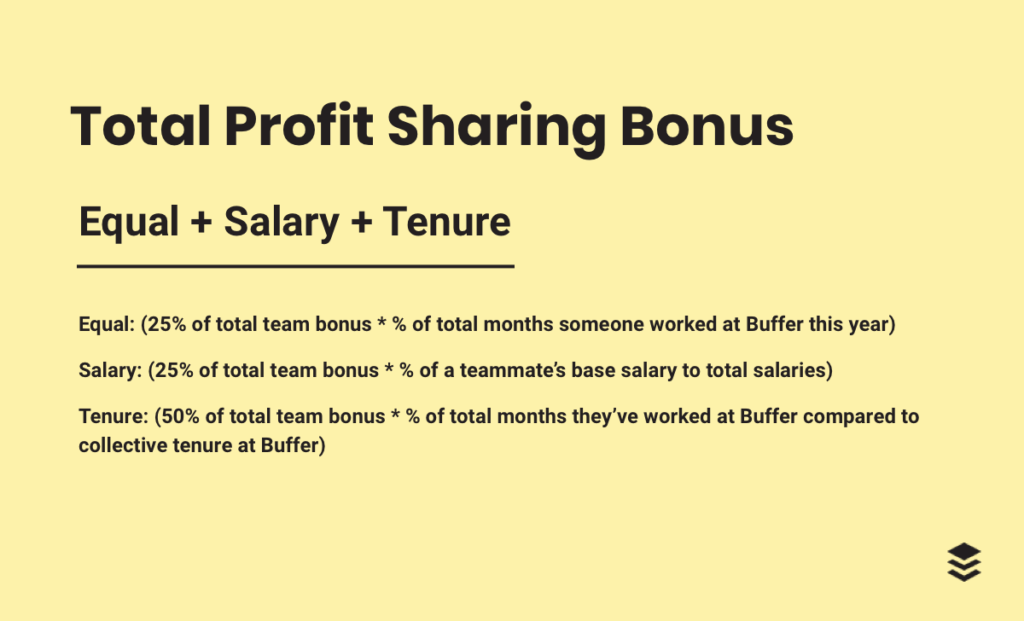When Buffer succeeds, we believe everyone on the team should benefit.
One of the ways we make this happen is by sharing some of our profits based on our annual financial results.
We haven’t always been profitable – here’s a look at our net profit numbers from the last four years:
- 2015: $17K
- 2016: Loss
- 2017: $2.41M
- 2018: $3.29M
Over these last two years of profitability, we’ve put in place a profit-sharing plan for the whole team, as well as set aside a chunk of money for charitable contributions. Read on to learn more about our formula for profit sharing and our process for selecting charitable contributions in our 2018 financial year.
In 2017, our first year of profit sharing, we gave $300,000 back to the team and saved $50,000 for charitable contributions. (You can learn more about the charities we supported here.)
In 2018, we created a formula to guide us in future profit sharing and charitable contributions (more on both of those below). We set aside $394,997 for profit sharing and committed to giving 20% of this amount – $78,999 – to non-profits.
What an honor to donate nearly $80,000 to charities we love!
Our profit sharing and charitable contribution formula
For much the same reason we created a salary formula, we decided to create a formula to help us execute profit sharing. We wanted a simple, consistent method based on our net income (revenue minus expenses minus income taxes) to determine how to distribute the company’s profits.
The first step was determining how much of our profit to distribute. We settled on an amount between 8% and 15%, based on the year’s performance and other strategic uses of excess cash. Additionally, we decided to allocate an additional 20% of the chosen profit share number for charitable contribution.

Once we knew the amount of profit to distribute, we needed to determine how it got shared within the team.
We used the following three components to allocate the profit share within the team:
- 25% is distributed equally to all team members based on their number of months of contribution to Buffer in the current year.
- 25% is based on the % of base salary as a component of total salaries. For those hired in the current year, their salary portion is based on their hire date.
- 50% is based on tenure. The longer someone has been at Buffer, the higher their total percentage of the profit share will be.
The final formula looks like this:

Let’s see how this looks in practice, considering a person at Buffer who makes $90,000, and has been on the team for three years. For this example, let’s say we’re a team of 80 people.
- 25% of the profit share ($394, 977) is $98,744.25, which, if distributed equally among 80 people who had all been at the company all 12 months of the year, would be $1234.30 per person.
- For the second 25%, we look at total salaries. As of our last profit sharing, we were spending $7,969,073 per year on salaries. So if someone makes $90,000 we would divide that by the total salaries multiplied by the bonus pool multiplied by 25%. So it would be ($90,000 divided by $7,969,073) multiplied by (394,977 divided by 25%) to make a total of $1115.18.
- For the final 50%, if the total number of years that 80 people have been at Buffer is 240 years we’ll divide the final portion of the profit share, $197,488.50 by 240, which is $822.87 per year. For this person, it would mean $2468.61.
So their total portion of the profit share would be $4818.09.
How a few other companies do profit sharing
As it turns out, we’re in good company when it comes to annual profit sharing. Buffer friend Hiten Shah recently shared how a number of different companies go about profit sharing with a Tweet cheekily headlined “Profit sharing is the new IPO.” Below are just a few examples:
Basecamp
As outlined in their handbook, Basecamp’s profit-sharing system is based on two questions at the end of the year:
“1. Was this year our most profitable year ever?
2. If yes, then how much better did we do than the previous best year? 25% of that profit will be split amongst employees.
If you’ve been working here for 2-5 years, you get 1 cut of the profit share, and if you’ve been working here for 5+ years, you get 2 cuts of the share. So, the more people who work at Basecamp for 2+ years, the more pieces of pie there are to distribute.”
Mailchimp
This blog post from Mailchimp outlines their unique process for profit sharing, which puts a bonus of up to 19% of an employee’s annual salary into everyone’s 401k plan each year, based on company performance.
Southwest
Profit sharing isn’t just for tech companies! Southwest Airlines has shared $543 million with its employees “through profit-sharing payments of 11.3 percent of each worker’s eligible compensation, the equivalent of more than five weeks’ pay.”
Next: Our collaborative process for charitable donations
Once we decided how much money we could commit to charitable contribution, the next question was: How do we choose the organizations to support?
We wanted to put thoughtful intention into our selection process, and we wanted to involve the entire team in the decision. I asked Arielle, who worked on this project, to describe the process. Here’s what she shared:
1. Form a charity task force
Our task force was composed of four teammates from three different areas of Buffer — Customer Advocacy, Marketing, and People. This group put thought into how best to facilitate the team’s involvement with nominating and voting.
2. Create a framework for the kinds of organizations to support
There are many thousands of incredible charitable organizations in the world, so we needed a focused framework that would guide us.
We decided to choose six charities — one representing each of our six values. Instead of a tiered donation structure like we did last year, we decided that each organization would receive an equal amount.
3. Invite the team to nominate organizations
Opening up nominations to the entire company was key to us. It was beautiful to see how each teammate interpreted our company values, and the process resulted in a list of 34 non-profits.
This nomination period occurred over 3.5 weeks, over the December holidays (while we didn’t choose this time frame on purpose, but it’s cool to think that the team might have been more in a “giving mood”).
4. Choose semi-finalists
Once the nominations were in, the charity task force went through the list and chose 18 semi-finalists — three for each Buffer value. We focused on charities that had a national or global reach, checked to ensure each one was a registered charitable organization, made sure to include several organizations that supported underrepresented groups in tech (our industry), and made an entire category for UK-based charities, since Buffer is in the final stages of incorporating a UK satellite office (more on that soon!).
5. Invite the team to vote on the final six organizations
Finally, we opened voting to the team. We shared a paragraph about each organization, with links and tax IDs so that teammates could do their own research. Then we asked teammates to choose the organization that they felt best reflected our six values.
Here are our 6 charities for this year
After a week of voting, these six charities were chosen to receive just more than $13,000 each:
The Nature Conservancy, representing our value of “Cultivate Positivity”
The Nature Conservancy epitomizes positivity in its inspiring messaging about our planet. They talk about how they are ”working to create a world where people and nature can thrive,” which is a beautifully positive sentiment.
Black Girls Code, representing our value of “Improve Consistently”
The impact that Black Girls Code makes is clear and tangible! As they teach and help black girls (currently underrepresented in tech roles) improve their programming skills, they inspire them to develop a love for technology and confidence to pursue a career in tech.
The Bail Project, representing our value of “Practice Reflection”
This organization embodies our reflection value: listen first, and seeking to understand before asking to be understood. As The Bail Project pays bail for people in need, they help restore the presumption of innocence, and combat racial and economic disparities in the U.S. bail system.
Pursuit, representing our value of “Act Beyond Ourselves”
The software development training program Pursuit truly exemplifies “acting beyond oneself” as they guide adults with the most need and potential to get their first tech jobs, advance in their careers, and become the next generation of leaders in tech.
Cool Earth, representing our value of ” Show Gratitude”
The UK-based Cool Earth empowers local communities to halt deforestation and its impact on climate change. Their mission displays both gratitude for the local communities who are closest to the threat and for everything nature offers to us.
charity: water, representing our value of “Default to Transparency”
As charity: water works to bring clean and safe drinking water to people in developing countries, they champion transparency by tracking every dollar and showing donors the projects they’ve helped to fund, and ensuring that 100% of funds go to the field for water projects.
These are all incredible organizations, and we are so grateful to support their work.
Over to you!
Does your company participate in profit sharing or charitable donations? We’d love to learn about it in the comments if so! Feel free to ask us any of your questions as well!
Try Buffer for free
190,000+ creators, small businesses, and marketers use Buffer to grow their audiences every month.




